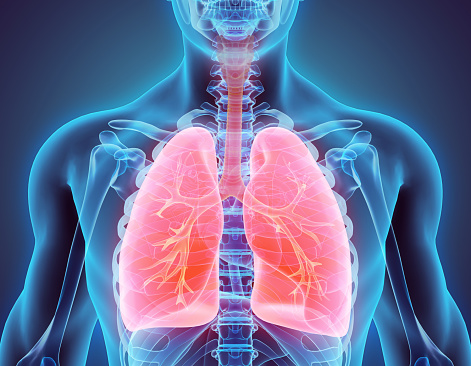
Lung diseases are the most common unhealthy conditions across the globe, caused due to unhealthy atmosphere, habits (like smoking) infections, and genetic abnormalities. Lungs are organs which expand and relax thousands of times daily to bring in oxygen and sent out carbon dioxide. Lungs diseases happen when there are any problems in any part of this
Let us discuss some of the diseases affecting the lungs.

The trachea (windpipe) branches into tubes called bronchi, which spread as smaller tube without the lungs. The following diseases are caused due to the problems in the airways:
- Bronchial Asthma: Due to spasm and inflammation in the bronchi causing wheezing and difficulty in breathing. Allergies, infections or pollution can increase asthmatic attack.
- Chronic obstructive pulmonary disease (COPD): During this condition, a person cannot exhale in usual ways, but with trouble breathing.
- Chronic bronchitis: This form of COPD brings a long term wet cough.
- Emphysema: Lung damage allows air to be trapped in the lungs in the form of COPD. Trouble blowing air out is its symptom.
- Acute bronchitis: This lung infection is usually caused by a virus.
- Cystic fibrosis: In tis condition, there is trouble in clearing mucus out of bronchi, leads to repeated lung infections.
The airways branch into bronchioles which again end in cluster of air sacs called alveoli. These air sacs form most of the lung tissue
Diseases affecting alveoli include:

- Pneumonia. An infection of alveoli, usually by bacteria or viruses, including the coronavirus that causes COVID-19.
- Tuberculosis Pneumonia that slowly gets worse. caused by the bacteria Mycobacterium tuberculosis.
- Emphysema. This happens when the fragile links between alveoli are damaged. Smoking is the usual cause. (Emphysema also limits airflow, affecting your airways.)
- Pulmonary edema. Fluid leaks out of the small blood vessels of the lung into the air sacs and the area around them. One form is caused by heart failure and back pressure in the lungs’ blood vessels. In another form, injury to your lung causes the leak of fluid.
- Lung cancer. It has many forms and may start in any part of the lungs. It most often happens in the main part of the lung, in or near the air sacs.
- Acute respiratory distress syndrome (ARDS). This is a severe, sudden injury to the lungs from a serious illness. COVID-19 is one example. Many people who have ARDS need help breathing from a machine called a ventilator until their lungs recover.
- 7.Pneumoconiosis. This is a category of conditions caused by inhaling something that injures the lungs. Examples include black lung disease from coal dust and asbestosis from asbestos dust.
The interstitium is the thin, delicate lining between the alveoli. Tiny blood vessels run through the interstitium and let gas transfer between the alveoli and blood.
Diseases affecting the interstitium

Interstitium lung disease (ILD). This is a group of lung conditions that includes sarcoidosis, idiopathic pulmonary fibrosis, and autoimmune disease
2.Pneumonia and pulmonary edema can also affect your interstitium. The right side of the heart gets low-oxygen blood from the veins. It pumps blood into the lungs through the pulmonary arteries.
Diseases affecting the blood vessels

1.Pulmonary embolism (PE). A blood clot (usually in a deep leg vein, called deep vein thrombosis) breaks off, travels to the heart, and gets pumped into the lungs. The clot sticks in a pulmonary artery, often causing shortness of breath and low blood oxygen levels.
2. Pulmonary hypertension. Many conditions can cause high blood pressure in pulmonary arteries. This can lead to shortness of breath and chest pain. The pleura is the thin lining that surrounds the lung and lines the inside of the chest wall. A tiny layer of fluid lets the pleura on the lung’s surface slide along the chest wall with each breath.
Lung diseases of the pleura include:
1.Pleural effusion. Fluid collects in the space between the lung and the chest wall due to Pneumonia or heart failure. Large pleural effusions can make it hard to breathe and may need to be drained.
2.Pneumothorax. Air may get into the space between the chest wall and the lung, collapsing the lung. 3.Mesothelioma. This is a rare form of cancer that forms on the pleura. Mesothelioma tends to happen several decades after it come into contact with asbestos. The chest wall also plays an important role in breathing. Muscles connect ribs to each other, helping the chest expand. The diaphragm descends with each breath, also causing chest expansion.
Diseases that affect chest wall include:
1.Obesity hypoventilation syndrome. Extra weight on the chest and belly can make it hard for the chest to expand. This may cause serious breathing problems.
2.Neuromuscular disorders. One might have trouble breathing when the nerves that control respiratory muscles don’t work the way they should. Amyotrophic lateral sclerosis and myasthenia gravis are examples of neuromuscular lung disease.
How to prevent lung disease ?
To avoid chronic lung disease, the following precautions are to be taken.
- Quit smoking. Avoid secondhand smoke.
- Reduce exposure to pollutants in the environment, at work, and at home.
- Exercise regularly. Aerobic exercise that increases heart rate is best.
- Eat a nutritious diet able to combat infections.
- Conduct regular Medical checkups and Clinical investigations to find lung conditions
- Get vaccinations for flue every year, and after 65, against pneumonia.
- If there is a risk for lung cancer, conduct screening tests through the Physician.
- Test at home for radon gas.
- Wash hands regularly, avoid touching face, and stay away from individuals who are sick.
We know that the Covid 19 pandemic is going uncontrolled and is affecting the Respiratory tract and the lungs to make the situation serious. We should take utmost care in protecting the lungs by understanding the diseases and the precautionary measures to stay safe and healthy.
.




